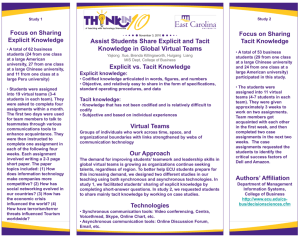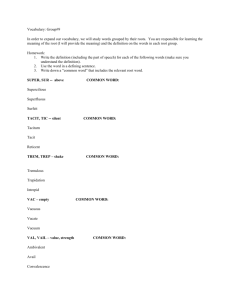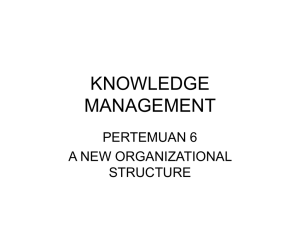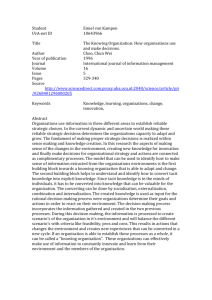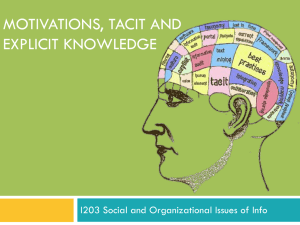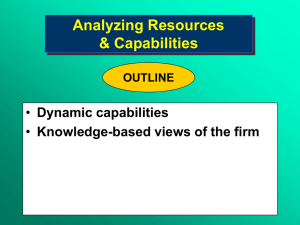The knowledge-Creating Company: How Japanese Companies Create the Dynamic of Innovation
advertisement
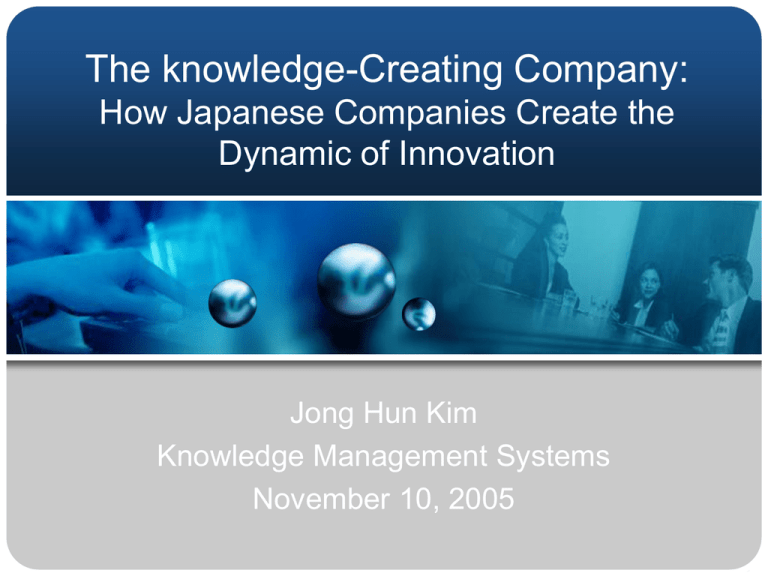
The knowledge-Creating Company: How Japanese Companies Create the Dynamic of Innovation Jong Hun Kim Knowledge Management Systems November 10, 2005 Overview • • • • • • • • About Authors The Distinctive Japanese Approach Tacit/ Explicit Knowledge Knowledge Conversion Enabling Conditions Management and Organizational Structure Implications Conclusion Authors • • • • • • • • Professor (Adjunct) Ikujiro Nonaka Dean of the School of Knowledge Science, Japan PhD (Business Administration), University of California MBA, University of California BS (Political Science),Waseda University Professor Hirotaka Takeuchi Dean, Hitotsubashi University Graduate School of International Corporate Strategy Ph.D. and M.B.A., the University of California, Berkeley The Distinctive Japanese Approach • Western Knowledge is based on explicit knowledge. – Organization is a machine for information processing. • Tacit knowledge is more important in Japan. – Organization is a living organism. • Tacit knowledge is highly personal and hard to formalize, difficult to communicate Tacit/ Explicit Knowledge • Tacit knowledge- Knowledge that we do not know we know. Difficult to articulate and generally expressible only through action. • Explicit knowledge- Knowledge that we know we know. Can be articulate, codified, stored, transferred through documents. Tacit/ Explicit Knowledge Tacit Knowledge (Subjective) Explicit Knowledge (Objective) Knowledge of experience (body) Simultaneous Knowledge (here and now) Analog Knowledge (practice) Knowledge of rationality (mind) Sequential Knowledge (there and then) Digital Knowledge (theory) Knowledge Conversion Tacit Tacit Tacit Socialization Externalization E I I I E I G I I I O Internalization Combination E E G G I Explicit O Tacit G Explicit G Explicit Explicit I=Individual, G=Group, O=Organization, E=Environment Knowledge Conversion Tacit Tacit to Explicit Socialization Externalization (Theory of group process and organizational culture) (Dialogue and collective reflection) Internalization Combination (Organizational learning) (Information processing) from Explicit Example of Socialization • Matsushita Electric Industrial Company – Problem: Automatic home bread-making machine. – Volunteered to apprentice themselves to the hotel’s head baker. – No one could explain why. – The secret for making tasty bread: stretching and twisting Example of Externalization • Honda City – Developing the car – Used a metaphor: Automobile Evolution – What will the automobile evolve into? – Tall and short car: Tall Boy – Man-maximum, Machine-minimum Example of Combination • Asahi Breweries – Grand concept: Live Asahi for live people – What makes beer appealing – Developed Asahi Super Dry beer: richness and sharpness – Cooperative product development Example of Internalization • Matsushita – New policy: reducing yearly working time to 1800 hours – Objective: innovating the mindset and management – One month experience, working 150 hours – Internalized through the one-month experience Enabling conditions • Intention – aspiration to goals • Autonomy – letting people act independently as far as possible • Fluctuation and creative chaos – to stimulate interaction between the organization and its outside environment • Redundancy – Enables the knowledge creation to take place organizationally • Requisite variety – Requires equal, fast access to information Organizational Knowledge Creation Process Middle-up-down Management Process • Top-down and bottom-up management both have limitations. • “Simply put, knowledge is created by the middle managers, who are often leaders of a team, or task force, through a spiral conversion process involving both the top and the front line employees.” • Middle managers act as catalysts. New Organizational StructureHypertext organization Implications • Create a knowledge vision. • Develop a knowledge team. • Build a high-density field of interaction at the front line. • Piggyback on the new-product development process. • Adopt middle-up-down management. • Switch to a hypertext organization. • Construct a knowledge network with the outside world. Conclusion • “Knowledge is taken as the basis for what an organization dose, but it’s important to know that creating knowledge can be as important as processing knowledge.” • Exchange of knowledge is in a very central role. The knowledge should be at hand, where it is needed, instantly. It also should be easily updated and delivered. • “Creating knowledge will become the key to sustaining a competitive advantage in the future.”

